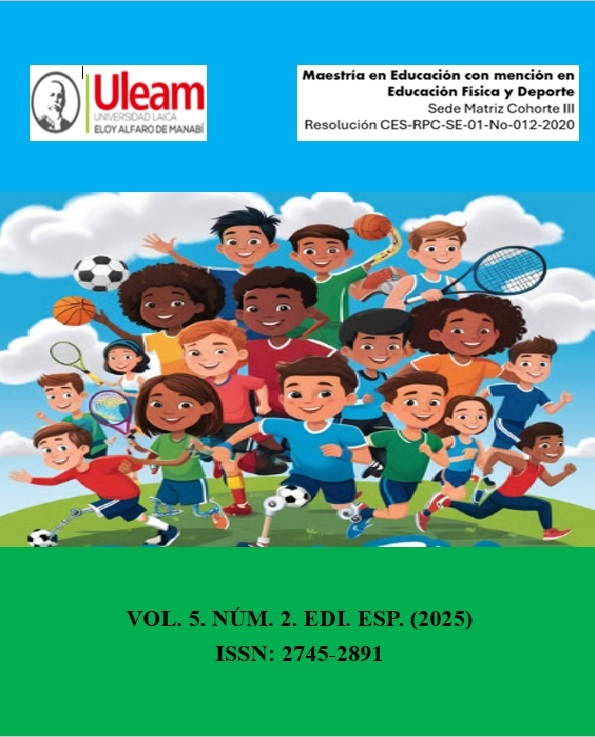Social Integration in the Cabuya-San Vicente Community: A Football Perspective
Abstract
Social integration refers to the process by which individuals or a community are incorporated into society by actively participating within it, overcoming the barriers of exclusion so that everyone has access to it and enjoys the same opportunities and rights. Therefore, this research focuses on the social integration of the Cabuya Community in the San Vicente Canton through soccer, seeking to ensure that community members feel an important part of it. Soccer is an extremely important tool within communities due to its integrative quality. Through this practice, values, specifically teamwork, are fostered, promoting social integration. Therefore, the research objective is to interpret the views of different authors on the effects of soccer as an agent of social integration in the Cabuya-San Vicente Community. The urgent importance of investigating the role of soccer in the social integration of Cabuya-San Vicente lies in the urgent need to address local problems with innovative and sustainable solutions.
Downloads
References
Almeida, T. V., Ribeiro, F., & Nunes, M. (2020). Effects of a soccer program on the development of psychosocial skills of young soccer players: A 2-year study. En Frontiers in Psychology, 11, 499.
Appelqvist-Schmidlechner, K., Haavalammi, N., & Kekonen, M. (2023). Benefits and underlying mechanisms of organized sport participation on mental health among socially vulnerable boys. Sports and Society, 26(2), 240–262.
Bardin, L. (2002). Análisis de contenido. Akal.
Carreño, A. et. al. (2024). Nutrición, Niñez y Migración: Desafíos para su Abordaje desde un Enfoque de Interculturalidad en Salud. VII Congreso Chileno de Salud Pública.
Cabrera Acosta, R. E., Bestard Revilla, A., Sierra Barbado, C. R., & González Pieras, J. (2023). Deporte, resiliencia y calidad de vida. Revista de Investigación Cuerpo, Cultura y Movimiento.
Cevallos, R., & Molina, G. (2025). Cohesión social en comunidades marginales: Estrategias y resultados. Revista Ecuatoriana de Desarrollo Social, 13(1), 85-104.
Creswell, J. W. (2018). Research design: Qualitative, quantitative, and mixed methods approaches (5th ed.). Sage Publications.
Daga, G., López Bóo, F., Van der Werf, C. (2024). Crecer en movimiento. Desafíos y oportunidades para la primera infancia migrante. Inter-American Development Bank (BID).
Decos Nápoles, F. (2025). El fútbol como una estrategia para el fortalecimiento de comunidades. MENTOR Revista De investigación Educativa Y Deportiva, 4(11), 213–230.
Espárrago Acosta, J. L. (2024). El fútbol como herramienta clave para el desarrollo social. Estudio de caso: Programa de liderazgo social en Zaragoza. Máster Universitario en Cooperación Internacional al Desarrollo, Universidad Pontificia Comillas.
Fernández, I. (2025). La violencia transforma el mapa migratorio de Ecuador. InSight Crime.
García, S., & Navarro, P. (2024). El fútbol como entorno seguro para habilidades sociales juveniles. Revista de Psicología del Deporte y la Actividad Física, 10(1), 55-74.
Gómez, A. (2019). Las relaciones interpersonales: concepto y características. Revista de Psicología, 25(2), 89-104.
Lincoln, Y. S., & Guba, E. G. (1985). Naturalistic inquiry. Sage Publications
Hernández Arellano, A. (2024). Xenofobia, la otra gran tragedia de los migrantes venezolanos. El Nuevo Siglo.
Hernández Sampieri, R., Fernández Collado, C., & Baptista Lucio, P. (2014). Metodología de la investigación (6ta ed.). McGraw-Hill Education
Molina-De-La-Torre, K. R., & Baldeón, F. (2025). Impacto de la práctica de futbol en la salud física de los niños escolares. HOLOPRAXIS. Revista de Ciencia, Tecnología e Innovación, 9(1).
Martínez, J. L., Gómez, A. B., & Rodríguez, M. J. (2021). Efectos de la práctica regular del fútbol en la salud cardiovascular. Revista Internacional de Ciencias del Deporte, 17(3), 134-148.
Organización Mundial de la Salud (OMS). (2016). Recomendaciones mundiales sobre actividad física para la salud. Obtenido de https://apps.who.int/iris/bitstream/handle/10665/44441/9789243599977_spa.pdf
Pavez-Soto, I. y Acuña Ramírez, V. (2025). Adolescentes migrantes no acompañados en Chile. Minuta de resultados Proyecto FONDECYT N° 1221337.
Pérez, M. (2022). La importancia de la confianza en las relaciones duraderas. Journal of Interpersonal Communication, 16(3), 55-68.
Sánchez Ortega, A. M., & Ortín Montero, F. J. (2021). Relación entre resiliencia y rendimiento en deportistas. Revisión sistemática. Revista de Psicología Aplicada al Deporte y el Ejercicio Físico, 6(2), e16.
Stake, R. E. (1995). The art of case study research. Sage Publications.
Urbano Canal, N. et. al. (2024). Escuelas colombianas, a renovarse para recibir a niños, niñas y adolescentes migrantes venezolanos. Revista Divulgación Científica, Universidad del Rosario, 7.
Yadav, V. R., & Bhanushali, K. (2025). The Role Of Community Policing In Enhancing Social Cohesion Through Sports: A Framework For Crime Prevention And Youth Engagement. Journal of Neonatal Surgery, 14(4).
Copyright (c) 2025 Adonis Parrales

This work is licensed under a Creative Commons Attribution-NonCommercial-NoDerivatives 4.0 International License.






